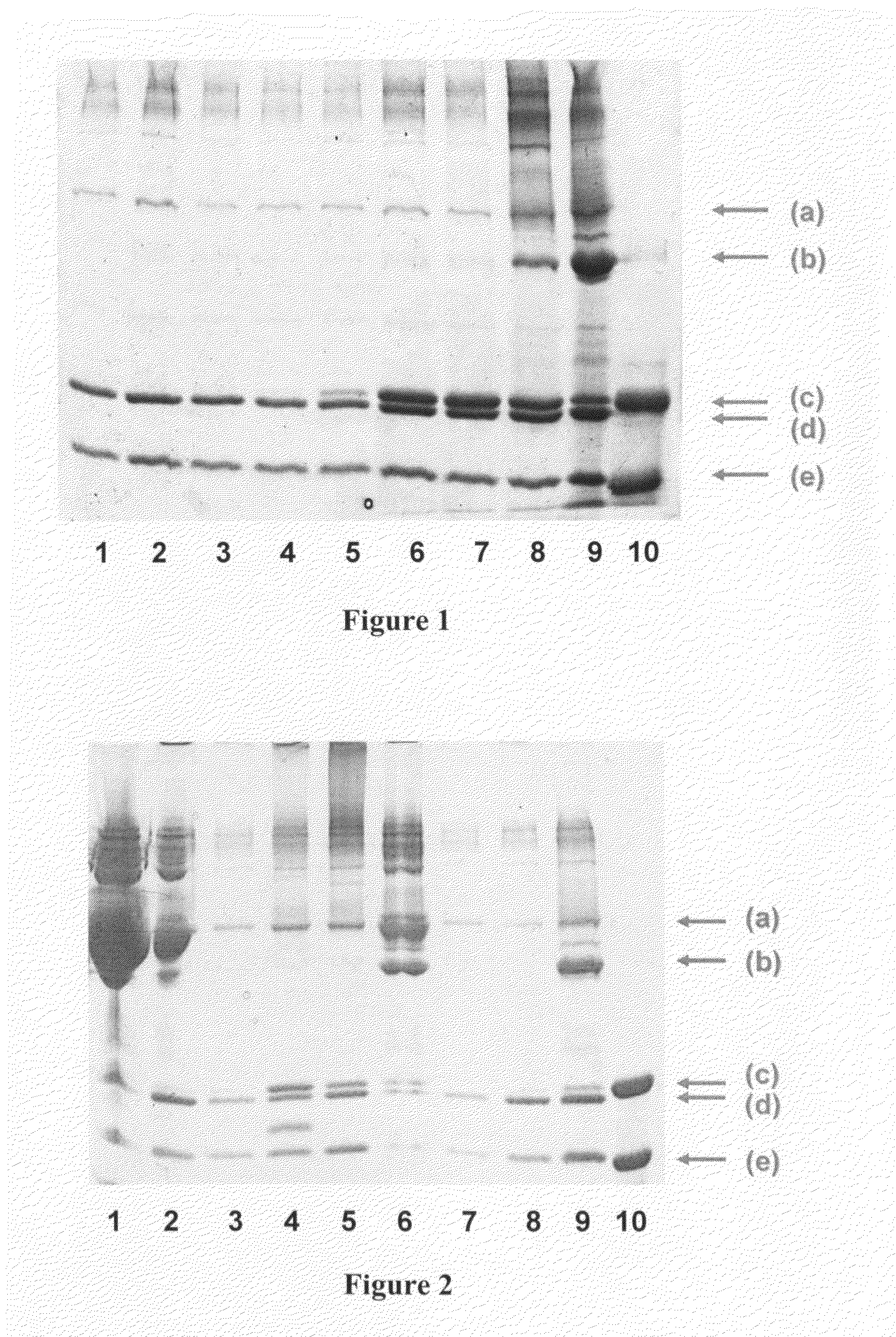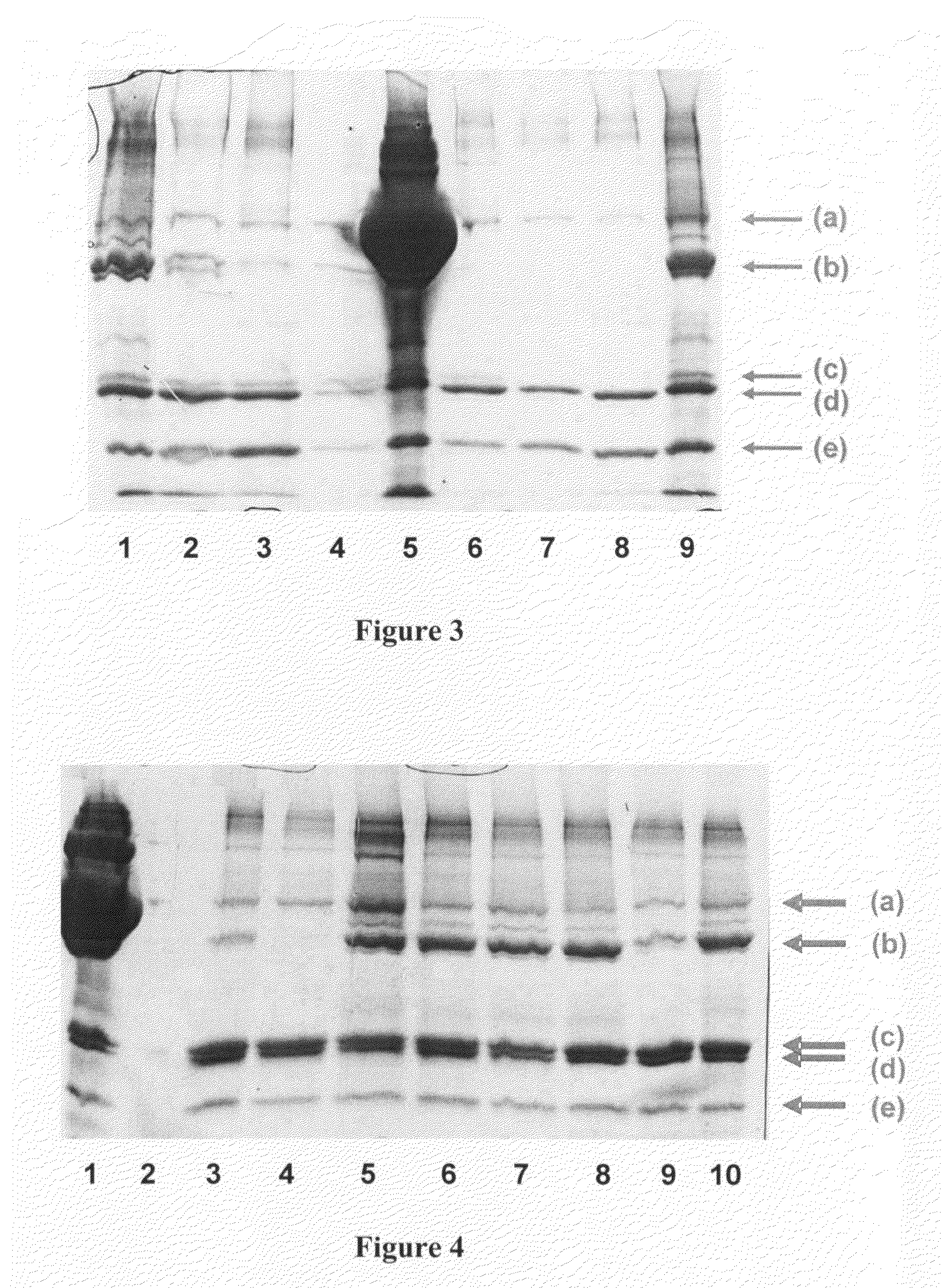Method for Concentrating, Purifying and Removing Prion Protein
a prion protein and purification technology, applied in the field of concentrating, purifying and removing prion proteins, can solve the problems of prior enrichment, no material or method is disclosed, and animals can become infected with prion-associated diseases
- Summary
- Abstract
- Description
- Claims
- Application Information
AI Technical Summary
Benefits of technology
Problems solved by technology
Method used
Image
Examples
example 1
Overall High Affinity Binding of Different Sepharoses to PrPSc
Experimental Design:
[0133]The binding affinity and specificity of prion proteins to various Sepharoses was investigated with recombinant prion proteins in the presence of a 1,000-fold excess of BSA. The recombinant prion proteins PrP-pure (alicon ag, product code P0001) and PrP-beta (alicon ag, P 0019 and P0027) were used as model substances for PrPC and PrPSc, respectively. The beta-form of bovine PrP(25-241) and mouse PrP(89-231), and the pure-form of bovine PrP(25-241) can be well distinguished by SDS-PAGE because of their different electrophoretic mobilities.
[0134]For the binding experiments 5 μg of the prion protein studied and 5 mg BSA were dissolved in 1 ml binding buffer containing 50 mM sodium phosphate pH 7. Depending of the experimental design the binding buffer contained additives such as EDTA or detergents. The mixture of Sepharose matrix and binding buffer was rotated in 1.5 ml vials for 1 h at 4° C. Subseq...
example 2
Concentration of Native Prion Proteins in Blood
Experimental Design:
[0153]The amount of PrPC in blood of healthy humans and animals is only marginal. Without any concentration step PrPC is not detected using conventional analytical methods such as Western Blot. However, applying Ni Sepharose High Performance pre-loaded with bovine PrP(25-241) pure-form to 20 ml blood, PrPC becomes visible.
[0154]Ni Sepharose High Performance pre-loaded with bovine PrP(25-241) was prepared by adding 5 ng of the recombinant prion protein to 20 ml of the Sepharose equilibrated with 50 mM phosphate buffer. The mixture was vortexed, and incubated while rotating for 1 h at 4° C.
[0155]The preparation of cell lysates and plasma from fresh cattle blood was carried out using standard protocols. For Example, the plasma fraction was prepared from 20 ml blood collected in EDTA tubes, after 1 / 10 dilution with sodium citrate to a final concentration of 10 mM. The citrate blood was diluted 1 / 1 with Gey's balanced sal...
example 3
Concentrating PrPSc in Blood after Spiking with Brain Homogenate
Experimental Design:
[0159]The nature of native PrPSc in blood is not known, although it seems likely that it has similar biochemical properties as PrPSc found in brain. We used PrPSc from brain homogenate (PrPSc concentration between 1 pg / ml and 1 ng / ml) as a model substrate to analyse its binding to Ni Sepharose High Performance pre-loaded with bovine PrP(25-241).
[0160]The concentration experiment was carried out as described under Example 2, except that various amounts of scrapie brain homogenate were added to the samples.
Results:
[0161]After spiking of 1 ml sodium phosphate buffer pH 8 with brain homogenate to a final concentration of 1 ng / ml PrPSc and subsequent 200-fold concentration, di-glycosylated, mono-glycosylated, and unglycosylated PrPSc as well as a multimeric forms could be detected in the Western Blot (FIG. 9). Thus, independent of its aggregation and glycosylation state, PrPSc efficiently binds to the Sep...
PUM
| Property | Measurement | Unit |
|---|---|---|
| pH | aaaaa | aaaaa |
| pH | aaaaa | aaaaa |
| pH | aaaaa | aaaaa |
Abstract
Description
Claims
Application Information
 Login to View More
Login to View More - R&D
- Intellectual Property
- Life Sciences
- Materials
- Tech Scout
- Unparalleled Data Quality
- Higher Quality Content
- 60% Fewer Hallucinations
Browse by: Latest US Patents, China's latest patents, Technical Efficacy Thesaurus, Application Domain, Technology Topic, Popular Technical Reports.
© 2025 PatSnap. All rights reserved.Legal|Privacy policy|Modern Slavery Act Transparency Statement|Sitemap|About US| Contact US: help@patsnap.com



